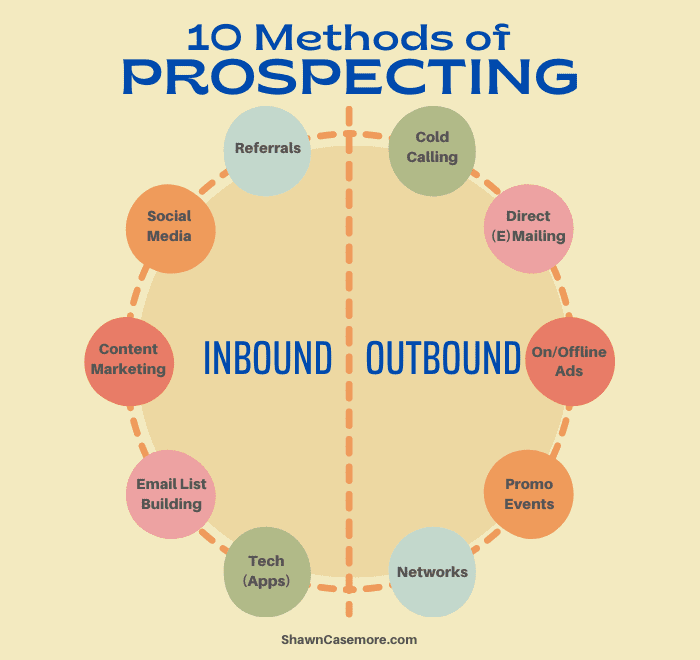Are you looking for methods of prospecting to find and connect with more of your ideal customers? Prospecting for clients and want to prepare prospects to buy?
Whether you are a sales leader, sales professional, entrepreneur, or business owner, finding new prospects is the most critical step in the sales process. But with buyers increasingly challenging to reach and so many prospecting techniques for sales to choose from, it can be challenging to know where to start.
Several methods of prospecting—including online, offline, and a combination of the two— are designed to help you fill your sales funnel and meet your sales goals. However, several critical elements are also required for successful prospecting, so you can be sure to achieve the best possible outcomes from your efforts.
Before we dive into various sales prospecting techniques, let’s first discuss what prospecting is and why it is crucial to any sales process.
What is Sales Prospecting?
 What is a prospect in sales?
What is a prospect in sales?
Sales prospecting, also known as customer prospecting, marketing prospecting, or business prospecting, is the process of identifying potential customers or clients (prospects) who may be interested in or need your product or service. It involves researching potential customers (leads), understanding their needs, and pitching a product or service that meets them.
The goal of prospecting is to:
- Identify your ideal prospects.
- Make a meaningful connection that enables you to form a relationship.
- Provide ongoing value to build a trusting relationship.
- Engage with and prepare your prospects to buy from you.
- Generate a high number of prospects to fill your pipeline.
Prospecting can be highly time-consuming; however, it’s a necessary evil to ensure a steady flow of new business while maintaining the overall health of your sales pipeline.
To help identify the customers we want to target, let’s distinguish between what is a lead and what is a prospect in sales.
The Difference Between “Lead” and “Prospect” in the Sales Process
 A lead is someone who has demonstrated some interest in your product or service. On the other hand, a prospect has been identified as a potential customer or client because they either have a need for or an interest in your product or service.
A lead is someone who has demonstrated some interest in your product or service. On the other hand, a prospect has been identified as a potential customer or client because they either have a need for or an interest in your product or service.
A lead converts to a prospect once they have been “qualified.”
Qualification involves:
- Assessing a lead’s level of interest in your product or service.
- Identifying the fit between your solution and the lead’s specific needs.
- Determine if the lead can buy (i.e., are they a decision-maker?).
- If the lead has an available budget that they are willing to spend.
There are several other criteria you can use to determine if the lead has the potential to become a customer or client; however, these are the most common.
Different prospecting methods enable you to identify leads worth your time and effort, so you can focus on converting them into paying customers or clients.
What Are Outbound Methods of Prospecting vs. Inbound?
When it comes to how to prospect for sales, there are three primary forms of prospecting: outbound prospecting, inbound prospecting, or a blend of the two (known as diversified prospecting).
Determining which is most suitable for your circumstances is essential to ensure it supports your sales strategy.
Outbound prospecting involves reaching out to potential customers or clients directly. The salesperson focuses their efforts “outward” to connect with potential customers or clients who may not be actively looking for your product or service but could still benefit from it.
Inbound prospecting relies heavily on marketing techniques to attract leads actively looking for a product or service like yours. With inbound prospecting, the salesperson focuses on qualifying the leads shared with them from marketing efforts.
Let’s explore some effective prospecting methods with examples of tactics you can use.
10 Methods of Prospecting in Sales (with Examples)

There are several methods of prospecting in sales, each with its advantages and disadvantages.
Here are ten prospecting methods with examples of tactics you can use to get started, as well as some tips for prospecting in sales:
1. Outbound Prospecting Method: Cold Calling & Cold Emailing
Cold calling involves contacting cold prospects by phone to generate interest in your product or service. I suggest using cold calling in conjunction with cold emailing to drive interest toward your email (i.e., increase your open rate).
Cold emailing involves sending emails to potential prospects (who most likely don’t know you) to introduce your company, products, and services.
These cold emails may contain a case study or video about your product or provide provocative information about your service.
If you are reaching out cold, it’s vital to personalize each prospect interaction and use provocative questions to drive interest, all while adding value.
2. Outbound: Direct Mail & Promotional Emails
 Sending promotional materials to potential customers with information about your products and services is another way to reach out to them, often via email.
Sending promotional materials to potential customers with information about your products and services is another way to reach out to them, often via email.
Direct mail involves sending a physical piece of mail to a potential customer. Both methods can build awareness of your product or service and generate interest and leads.
For example, if you’re a real estate agent trying to sell a property, you might use direct mail to send brochures and flyers to potential buyers in the area mentioning an upcoming open house.
I’m a fan of direct mail over promotional emails. The costs and effort behind direct mail might be more significant. However, too many promotional emails can get you labeled as a spammer, which makes further outreach difficult.
3. Outbound: Online (and Offline) Advertising
Advertising your products and services on television and radio or in newspapers, magazines, and online platforms can help you reach a larger audience of prospects.
Online advertising is a cost-effective way to target specific demographics and generate leads through platforms like Google, Facebook, and LinkedIn. Offline advertising, such as billboards and print ads, can generate interest in your product or service.
For example, if you’re trying to sell a new mobile app that supports better health, you could place ads on a social media platform such as Facebook or Instagram, targeting people who might be interested in your technology and the problem it solves.
You could also take out an ad in a related magazine and, in doing so, use a combination of online and offline advertising.
4. Outbound: Promotional Events
Promotional events are another form of outbound prospecting.
Trade shows and conferences are excellent opportunities to meet potential customers or clients and promote your product or service. These events are a great way to build brand awareness, generate leads, and establish relationships with sales prospects.
The advantage of promotional events is that they allow you to connect with potential prospects and provide a hands-on experience with your product or service.
For example, if you’re trying to sell a new line of beauty products, you could host an event where potential customers can try out your products and ask questions.
5. Outbound: Network at Events
 Networking has been around for a long time; however, it is still considered a very effective method of prospecting for clients.
Networking has been around for a long time; however, it is still considered a very effective method of prospecting for clients.
You can connect with potential clients and establish meaningful relationships by attending events related to your industry. It is also an excellent interactive way to build your brand and expand your reach.
Networking allows you to generate leads through conversations, meeting potential clients, and learning about their needs and preferences, enabling you to adjust your approach in real time.
For instance, say you sell insurance and are attending a conference. You meet representatives from a large corporation there, and after chatting with them, you learn that they need better commercial insurance coverage. You then have the opportunity to share your services and identify a solution (i.e., better coverage) from which you think they’ll benefit.
6. Inbound Prospecting Method: Ask for Referrals
Asking for referrals is another effective way of getting prospects. It involves reaching out to your current clients and asking them to refer you to others who might benefit from investing in your product or services.
Referrals can be a compelling way to generate leads because you are endorsed by someone your prospect knows and (presumably) trusts.
Additionally, referrals can help you bypass the initial stages of prospecting techniques in sales. The prospect will likely offer you more trust than if you had connected through other means.
To solicit referrals, you can offer incentives to customers for introductions to others in their network, done individually or through a more formal referral program.
7. Inbound: Social Media
 Social media has become a powerful tool for sales prospecting.
Social media has become a powerful tool for sales prospecting.
With billions of people on social media platforms (such as Facebook, LinkedIn, Instagram, and YouTube), connecting with prospects and forming relationships is easier than ever.
Social media prospecting involves both proactive and reactive methods. For example, you might join some LinkedIn groups where your prospects are likely to be and proactively reach out to suggest a connection.
Alternatively, using social listening tools to understand your prospect’s needs, then developing and sharing content related to solving these needs would be a more reactive approach as you wait for the prospect to engage with your content and reach out to you.
8. Inbound: Content Marketing & Other Web Content
Content marketing is one of the most effective ways to attract potential customers to your business.
An inbound prospecting technique that involves creating educational material, content such as blog posts, videos, or webinars addresses the pain points of your target audience.
Content marketing can allow you to reach a broader audience than you might through other outbound prospecting methods. In addition, creating valuable content can attract prospects interested in your industry or niche.
Let’s say you’re a financial advisor creating a blog post about retirement planning. A potential client searches for retirement planning tips online and finds your blog post. Presuming they read and are impressed by your expertise, they may contact you for more information.
9. Inbound: Email List Building
By offering valuable content, you can attract potential customers to your website and encourage them to sign up for your email list. Once they’ve subscribed, you can nurture these leads by sending them relevant communications through email marketing and moving them through your sales funnel.
Using the example above of the Financial Advisor, you might create a free guide to help people prepare for retirement. In exchange for downloading this guide, you can ask visitors to your website to provide their email addresses.
Once you have their email address, you can begin nurturing them through email marketing and suggesting a “complimentary call.” Then, for those that take you up on your offer, transition them from your email to your sales funnel.
10. Inbound: Technology & Sales Prospecting Apps

Another effective method of inbound prospecting is through sales prospecting apps. These apps allow you to reach potential customers through messaging apps such as WhatsApp, Facebook Messenger, or LinkedIn.
Using apps, you can reach potential customers less intrusively than by cold calling or traditional email marketing.
An example of using these apps for prospecting is by sharing valuable content with prospects. For example, send a link to a blog post that addresses a pain point they are likely to have.
By providing valuable content, you can begin building a relationship with potential customers and move them through your sales funnel.
Ignite Sales Growth with Diversified Methods of Prospecting
Prospecting is an essential part of any successful sales strategy.
Prospecting techniques for sales are most effective when you diversify your prospecting approach. And can help you reach a higher volume of potential customers, maximizing your chances of making a sale.
Testing different approaches and measuring their effectiveness is the best way to optimize a diversified prospecting business strategy.
Diversifying your approach is strategic prospecting and can help you identify which methods bring you the most success. Which allows you to focus your time on the most effective tactics. With a diversified approach, you can ensure you’re reaching the right prospects and increasing your chances of closing a sale.
Remember that prospecting in sales is not a one-size-fits-all approach. Instead, test, apply, measure, and repeat. That’s your best formula for prospecting success!
© Shawn Casemore 2023. All Rights Reserved.


Share This Article
Choose Your Platform: Facebook Twitter Google Plus Linkedin